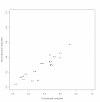A(H1N1) pandemic influenza and its prevention by vaccination: paediatricians' opinions before and after the beginning of the vaccination campaign
- PMID: 21342511
- PMCID: PMC3050752
- DOI: 10.1186/1471-2458-11-128
A(H1N1) pandemic influenza and its prevention by vaccination: paediatricians' opinions before and after the beginning of the vaccination campaign
Abstract
Background: In June 2009, the World Health Organization declared an A(H1N1) influenza pandemic. In October 2009, the largest vaccination campaign in Canadian history began. The aim of this study was to document paediatricians' knowledge, attitudes and practices (KAP) regarding A(H1N1) pandemic influenza and its prevention by vaccination just after the beginning of the A(H1N1) vaccination campaign and to compare the results with those obtained before campaign initiation.
Methods: A self-administered mail-based questionnaire was sent to all Canadian paediatricians. Questionnaires were analyzed in two subsets: those received before and after the beginning of the vaccination campaign.
Results: Overall the response rate was 50%. Respondents' characteristics were comparable between the two subsets. Before the beginning of the campaign, 63% of paediatricians perceived A(H1N1) pandemic infection as a serious disease, that would occur frequently without vaccination compared to more than 75% after. Before the vaccination campaign, half of respondents or less thought that the A(H1N1) vaccine was safe (50%) and effective (35%) compared to 77% and 72% after. The proportion of paediatricians who reported they had received sufficient information on A(H1N1) vaccine increased from 31% before to 73% after the beginning of the vaccination campaign. The majority of respondents intended to get vaccinated against A(H1N1) influenza themselves (84% before and 92% after). Respondents' intention to recommend the A(H1N1) vaccine to their patients increased from 80% before the beginning of the campaign to 92% after. In multivariate analysis, the main determinants of paediatricians' intention to recommend the A(H1N1) vaccine were their intention to get vaccinated against A(H1N1) influenza themselves and a belief that A(H1N1) vaccine would be well accepted by health professionals who administer vaccines to the public.
Conclusion: Results of this study show important increases in physicians' level of confidence about A(H1N1) vaccine's safety and immunogenicity and their willingness to recommend this vaccine to their patients. These changes could be explained, at least partially, by the important effort done by public health authorities to disseminate information regarding A(H1N1) vaccination.
Figures

References
-
- Chan M. World now at the start of 2009 influenza pandemic. 2009. http://www.who.int/mediacentre/news/statements/2009/h1n1_pandemic_phase6... 2009-06-11 [cited 2009-10-26]
-
- Greenberg J, Fox W. H1N1: media and message. Globe and Mail. 2009. http://www.theglobeandmail.com/news/opinions/h1n1-media-and-message/arti... accessed October 4 2010.
-
- Wordpress.com. Forget H1N1, The Real Pandemic is Hysterical Media Coverage. 2009. http://mediacoachblog.wordpress.com/2009/11/08/forget-h1n1-the-real-pand... accessed October 4 2010.
-
- Blackwell T. H1N1 flu nears peak, experts suggest. The Vancouver Sun. 2009. http://www.vancouversun.com/health/h1n1/H1N1+nears+peak+experts+suggest/... accessed October 4 2010.
-
- Fitzpatrick M. Brace for more H1N1 deaths, Canada's top doctor warns. The Vancouver Sun. 2009. http://www.vancouversun.com/health/h1n1/Brace+more+H1N1+deaths+Canada+do... accessed October 4 2010.
MeSH terms
Substances
LinkOut - more resources
Full Text Sources
Medical

